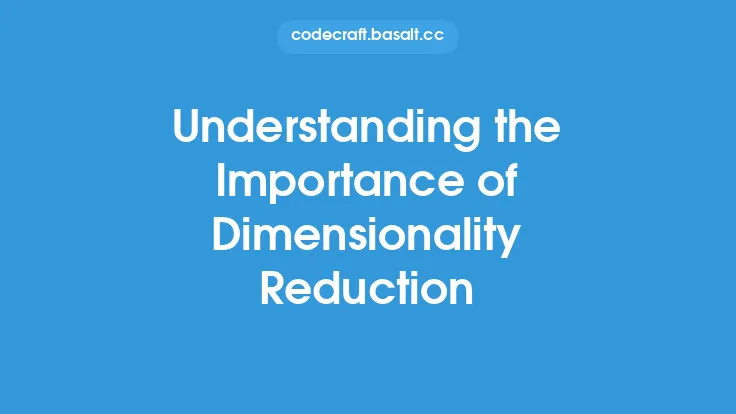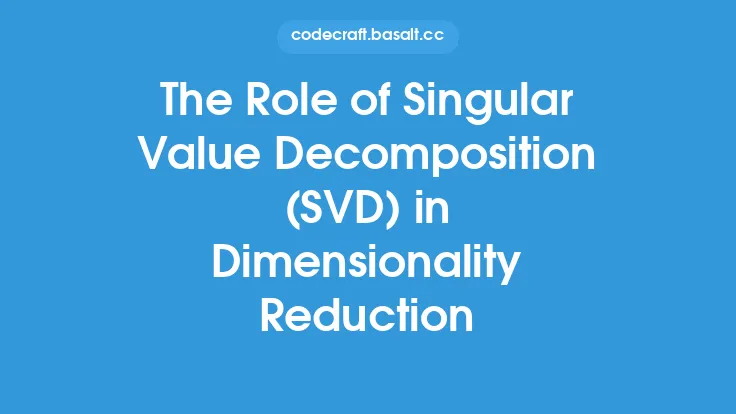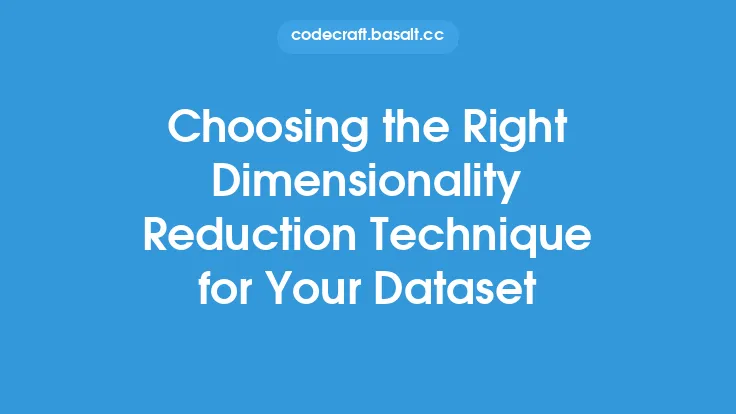Dimensionality reduction is a crucial step in the machine learning pipeline, as it enables the transformation of high-dimensional data into a lower-dimensional representation, making it easier to analyze, visualize, and process. This technique has a significant impact on model performance and interpretability, as it helps to reduce the curse of dimensionality, improve data quality, and enhance the overall understanding of the data. In this article, we will delve into the details of how dimensionality reduction affects model performance and interpretability, and explore the various techniques and considerations involved in this process.
Understanding the Curse of Dimensionality
The curse of dimensionality refers to the phenomenon where high-dimensional data becomes increasingly sparse and difficult to analyze as the number of features increases. This can lead to a range of problems, including overfitting, underfitting, and poor model performance. Dimensionality reduction helps to mitigate these issues by reducing the number of features in the data, thereby improving the signal-to-noise ratio and making it easier to identify patterns and relationships. By reducing the dimensionality of the data, we can also reduce the risk of overfitting, as the model has fewer parameters to learn and is less likely to fit the noise in the data.
Impact on Model Performance
Dimensionality reduction can have a significant impact on model performance, as it enables the selection of the most relevant features and the elimination of redundant or irrelevant ones. By reducing the number of features, we can improve the model's ability to generalize to new, unseen data, and reduce the risk of overfitting. Additionally, dimensionality reduction can help to improve the model's computational efficiency, as it reduces the number of parameters that need to be learned and the amount of data that needs to be processed. Some common metrics used to evaluate the impact of dimensionality reduction on model performance include accuracy, precision, recall, F1 score, and mean squared error.
Techniques for Dimensionality Reduction
There are several techniques available for dimensionality reduction, each with its own strengths and weaknesses. Some of the most common techniques include principal component analysis (PCA), singular value decomposition (SVD), t-distributed Stochastic Neighbor Embedding (t-SNE), and autoencoders. PCA is a linear technique that projects the data onto a lower-dimensional subspace, while SVD is a factorization technique that decomposes the data into a set of orthogonal components. t-SNE is a non-linear technique that maps the data to a lower-dimensional space, while preserving the local structure and relationships. Autoencoders are a type of neural network that learns to compress and reconstruct the data, and can be used for dimensionality reduction.
Considerations for Dimensionality Reduction
When applying dimensionality reduction, there are several considerations that need to be taken into account. These include the choice of technique, the selection of the number of dimensions, and the evaluation of the results. The choice of technique depends on the nature of the data and the goals of the analysis, and may involve a combination of linear and non-linear techniques. The selection of the number of dimensions is also critical, as it can affect the quality of the results and the interpretability of the data. Some common methods for selecting the number of dimensions include cross-validation, grid search, and permutation feature importance.
Evaluating the Results of Dimensionality Reduction
Evaluating the results of dimensionality reduction is crucial to ensure that the technique has been effective in reducing the dimensionality of the data while preserving the important information. Some common metrics used to evaluate the results of dimensionality reduction include the reconstruction error, the explained variance ratio, and the silhouette score. The reconstruction error measures the difference between the original data and the reconstructed data, while the explained variance ratio measures the proportion of variance explained by the selected features. The silhouette score measures the separation between clusters and the cohesion within clusters.
Interpreting the Results of Dimensionality Reduction
Interpreting the results of dimensionality reduction requires a deep understanding of the technique used and the nature of the data. The results of dimensionality reduction can be visualized using a range of techniques, including scatter plots, heatmaps, and clustering algorithms. The interpretation of the results depends on the goals of the analysis and the research question being addressed. For example, in a clustering analysis, the results of dimensionality reduction can be used to identify clusters and patterns in the data, while in a regression analysis, the results can be used to identify the most important features and relationships.
Real-World Applications of Dimensionality Reduction
Dimensionality reduction has a wide range of real-world applications, including image and speech recognition, natural language processing, and recommender systems. In image recognition, dimensionality reduction can be used to reduce the number of features in an image, making it easier to classify and recognize. In speech recognition, dimensionality reduction can be used to reduce the number of features in a speech signal, making it easier to recognize and transcribe. In natural language processing, dimensionality reduction can be used to reduce the number of features in a text document, making it easier to classify and cluster.
Future Directions for Dimensionality Reduction
The field of dimensionality reduction is constantly evolving, with new techniques and applications being developed all the time. Some of the future directions for dimensionality reduction include the development of new non-linear techniques, the application of dimensionality reduction to large-scale datasets, and the integration of dimensionality reduction with other machine learning techniques. Additionally, there is a growing need for dimensionality reduction techniques that can handle high-dimensional data with complex relationships and non-linear structures. As the field continues to evolve, we can expect to see new and innovative applications of dimensionality reduction in a wide range of fields.





